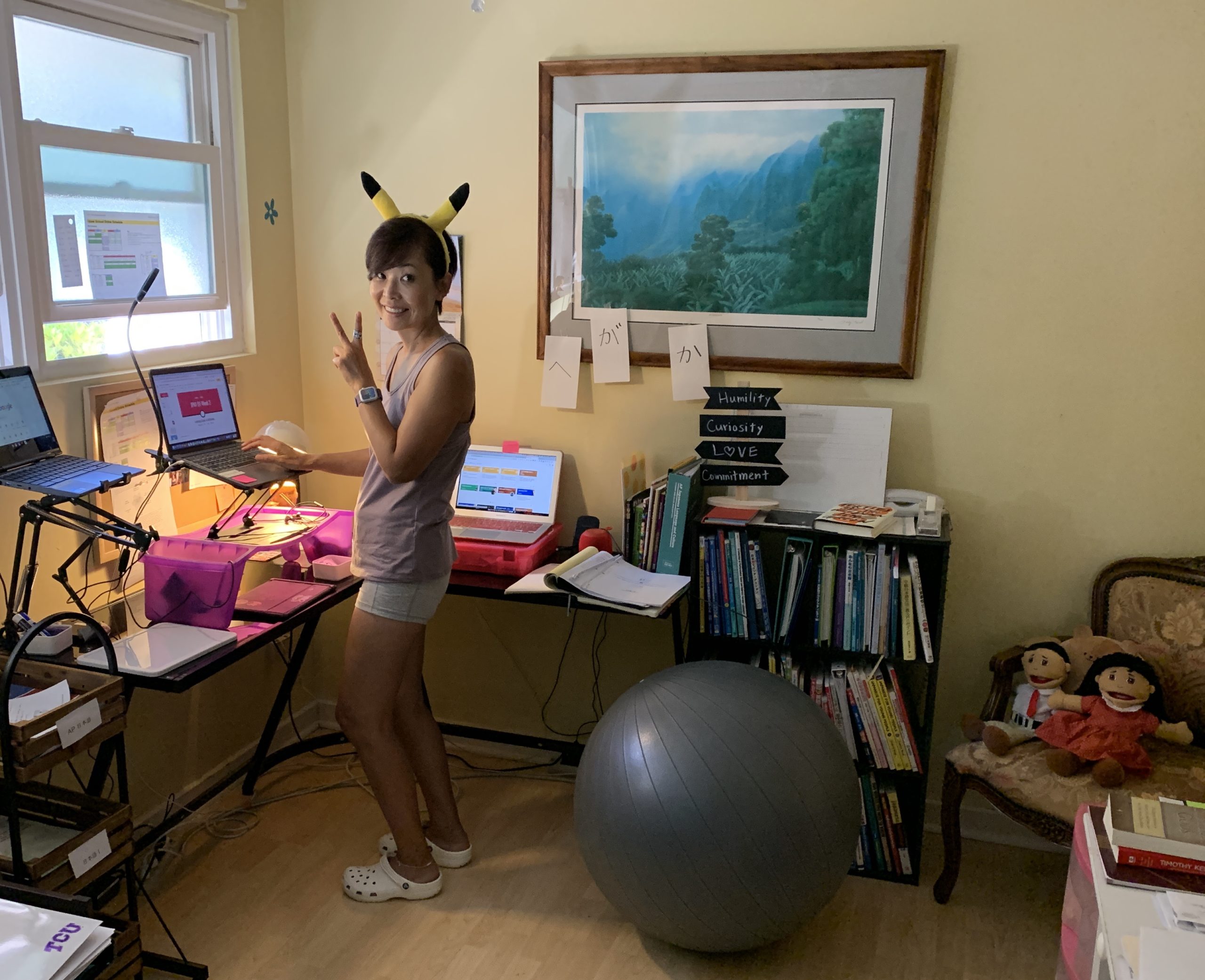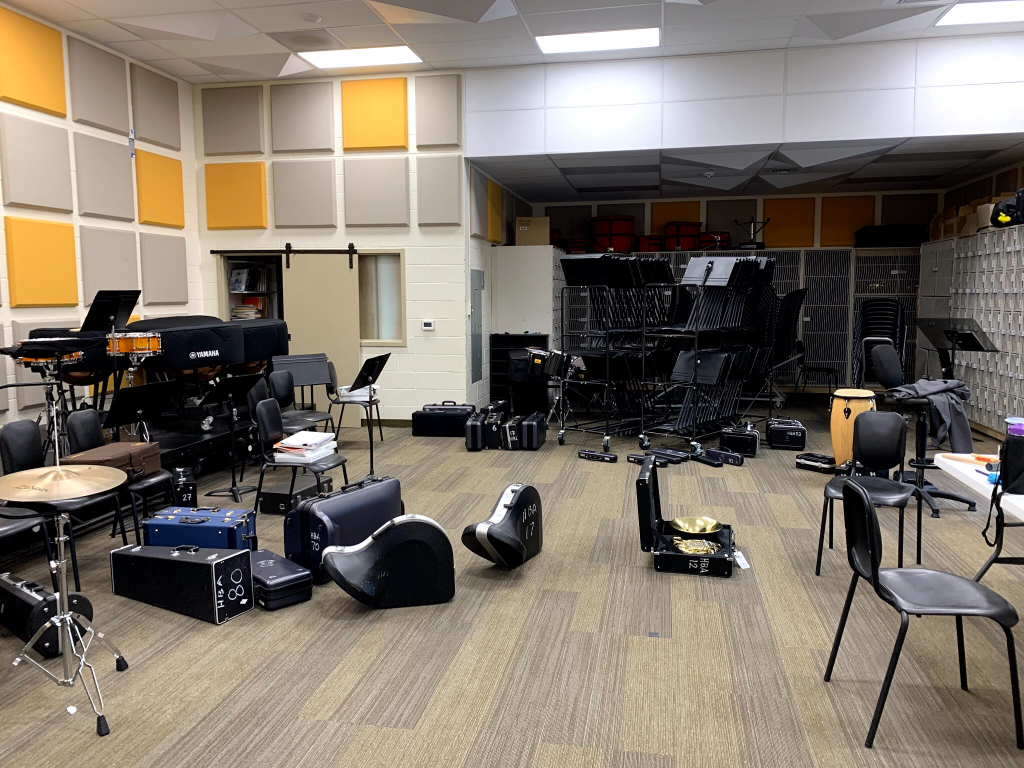Teachers Adapt to Online Learning


“By the time my daughter and I arrived [back in Hawaii], [the airport] was virtually empty. It was eerie; I have never seen anything like it,” Yoo said. “Because of that kind of experience, I kind of knew, online school for sure,” she added. Shortly after, Hawaii Governor David Ige issued a stay-at-home order on March 23, and HBA classes subequently went online in the fourth quarter, confirming Yoo’s fears. While it was clear that school would be online after spring break, most teachers didn’t expect distance learning to continue into the current school year. English teacher Ryan Frontiera, social studies teacher Lynne Nakano, and visual arts teacher Juri Yamashita all shared that they only expected online learning to last for a few weeks or so.
HBA students and teachers were thrown headfirst into a completely new way of learning. Both groups are adapting to online school, but it’s been an especially turbulent time for teachers, who have had to reassess what their classrooms should be like and find ways to preserve the quality of student education in previously uncharted territory.
High school principal Marsha Hirae said that the summer was filled with planning and adapting to constant changes. “Our department chairs all weighed in…they came back to work to try and help us figure this out, so there was a tremendous amount of planning and there still is plenty going on even right now,” she stated. Frontiera and Yamashita, as well as math teacher Aaron Kondo, taught summer school and used their classes to try new systems and practices in case the school year started online. “It helped to just stay on my toes as a teacher, and kind of try out different things in terms of how we do assessments, or how we assign homework, and if we do group work,” Kondo said. He started doing recorded lessons to make classes less monotonous and plans to continue even if the school transitions to the 50-50 in-person concurrent schedule. Kondo also gave a larger number of collaborative assessments, having students work together on shared Jamboards and within small group online meets.
After experiencing a fully online fourth quarter, teachers are approaching this year with new goals and philosophies toward distance learning. Frontiera said, “I’m trying to figure out how to give really clear instructions, and let people go and do meaningful tasks and not just busy work. And then the other thing I have learned is just how important it is to be around other people to discuss and share ideas, especially when you’re reading literature and comparing thoughts and ideas about that. So I’d like it that whenever I’m on camera with my students, we are doing face-to-face interaction [before] they have time to go off and work and complete things on their own.” Nakano, the Social Studies Chair, added, “The collaborative part of learning where you feed off each other, you build a discussion and you work with your group…is really important in social studies. We don’t want to just be the kind of social studies where it’s like: fact, remember, test, you know. So I’ve been doing small group meets online and trying to create those, so all my classes are in little groups.” Director of Counseling Danford Chang offered his perspective on the current circumstances, saying, “I think there’s certain challenges and certain advantages, so enjoy the advantages and do what you can to minimize the challenges.” Chang named a few positive aspects of online learning, including being able to spend more time with family at home and getting more sleep because there’s no more commute time.
With the fourth quarter distance learning experience behind them, Hirae said that the school provided teachers with training and resources to prepare for distance learning in the new school year. Yoo has found many useful apps for her classes, such as Pear Deck, Edpuzzle, Wakelet, as well as Flipgrid, which is her “go-to app” this year. She said, “I love it so much that I want other teachers to start using it.
For teachers who instruct courses that are particularly challenging to teach through a screen, adjustments are needed. Band director Dwaine Woo commented, “I think a very big component of Band is gone because we don’t have that interaction of getting together and playing. It’s sort of like, you want to play volleyball, but it’s only you.” Woo is choosing to start the year by teaching lessons on music theory, but, he said, “The goal for excellence within music, learning musicianship and all that, hasn’t changed; I’m just learning how to adjust and how we go about doing that.”
Yamashita ordered art supplies over the summer in anticipation of online learning, and had students pick them up from the school. She teaches through live demonstrations, projecting her desk on Google Meet as she works. Biology teacher Risha Mishima is now focusing on doing labs where students can improve their visual analysis skills, as hands-on labs are no longer feasible.

The transition has been a journey full of constant obstacles for faculty, requiring them to innovate and quickly adapt to changes. Hirae said, “It was a tremendous amount of work for all the principals, for President Ron Shiira, for the physical plant staff, for everybody. But we’re excited to do it because we want the kids to be able to come back.” Currently, the planned return to in-person school under the 50-50 concurrent learning schedule is slated for September 14. Chang acknowledged that it has been a demanding time, but he believes that “when God asks you to do something, He equips you to do it, and that’s skill wise as well as energy wise.”
So far, teachers have said that distance learning has come with its benefits and shortcomings. Yoo, Frontiera, Nakano, Kondo, and Woo all said that online school can’t truly recreate the human relationships and collaboration that used to be present in a regular school day. Frontiera stated, “Part of why I like teaching at a high school is the energy and enthusiasm of people walking in the room and chattering and the small incidental contact you have. And I just think that you can’t replicate the human connection experience through a screen, even though it’s the best thing we have.”
However, teachers are finding unexpected positives. Woo believes that the situation allows his students to “develop the real, deeper musical skills that they wouldn’t have gotten otherwise.” He added, “We have to think about what it really means to be a musician and learn those traits and skills.” Kondo said, “Being online gives you a little bit more freedom with your time, especially if you’re doing things from home, in the sense that you don’t have to worry about driving through traffic to get to school and to get back home.” He used to live in Mililani, and his daily commute took between 30 to 45 minutes.
It’s been a learning experience for both students and teachers, but faculty do have some tips to give students. Kondo, Yoo, Frontiera, and Nakano encouraged students to be self-directed learners and take initiative. Yoo emphasized the importance of asking questions, saying, “Better to stop the teacher when you have questions at the moment rather than waiting until just before the test or just before the quiz.” Frontiera added, “They have to be very intentional about being assertive and stepping in and asking for what they need; don’t assume the teacher can see that you’re struggling in class.”
Woo and Chang advised students to set up a work space specifically for school, and Mishima said students should “make sure [they] have a strong Internet connection, and continue to build that communication skill, even though it’s virtual, [by] responding to emails.” Yamashita keeps a planner with her schedule marked down, and encourages students to do the same.
These teachers also point out that students need to find ways to take care of themselves, whether it be through enjoying nature, finding new hobbies, or spending time with family. Nakano finds solace in going outdoors and visiting beaches or hikes that are normally crowded with tourists. She said, “We’re going to also have to figure out how to work hard, play hard.”
